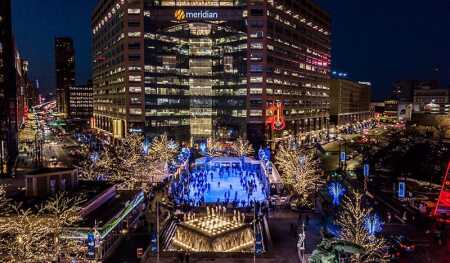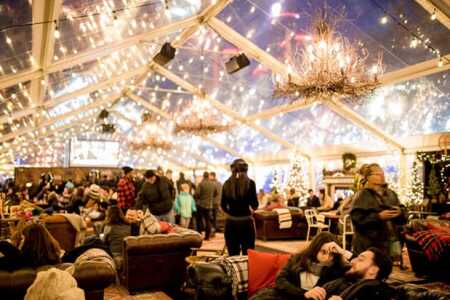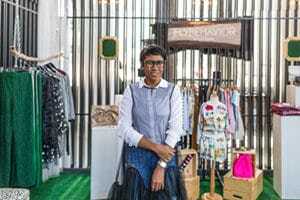
A combination of lighting, public art, and unique retail moved pedestrians up and down the streets, enticing visitors to make the walk from the northernmost market, inside a building bordering Campus Martius Park, down Woodward Avenue to a family-oriented igloo village nestled in the Spirit of Detroit Plaza. (Downtown Detroit Partnership)
Thoughtful placemaking is fundamental to the success of any economically and socially viable city. Detroit’s downtown parks are both public assets and important attractions throughout each of Michigan’s four seasons.
Using the natural elements of the park environment that change from season to season allows for incredible variation of activation, all in the heart of Detroit’s urban core. A sandy beach emerges during summer programming, and winter programs—like the most recent Winter in Detroit activation—prove just how enchanting a snowy wonderland can be.
“We wanted to catalyze investment in ongoing downtown infrastructure improvement, encourage authentic community connections, and develop a place where local entrepreneurs could thrive,” says Helen D. Johnson, vice president of Quicken Loans Community Investment Fund (QLCIF), the organization that supported Winter in Detroit.
Register for ULI Spring Meeting
QLCIF sees investment in public spaces as critical to the success of Detroit and to the quality-of-life issues that affect community residents, local businesses, and the 17,000 team members who are part of the Quicken Loans Family of Companies.
In partnership with Downtown Detroit Partnership (DDP), the city of Detroit, Groundswell Design Group, and Bedrock, Winter in Detroit was created to add new activation and aesthetic elements to what has traditionally been a busy season of winter-themed activities and programming in downtown Detroit.
“Placemaking and expanded activations like Winter in Detroit give us an opportunity to enhance the quality of life for our city and region. It helps us create an emotional bond to a place, developing a personal connection that makes us want to keep coming back, says Robert Gregory, chief planning and public space officer, DDP.
Building on the downtown park’s existing winter festivities—which include an ice-skating rink, the annual Christmas tree lighting, and many more activations in the seven downtown parks—Winter in Detroit added four distinct shopping districts, a ski lodge–inspired indoor gathering space, activities, and entertainment.
“We had very high expectations for what Winter in Detroit could provide to residents, visitors, and local businesses,” says Johnson. “We saw opportunities to use design and programming as tools to build social fabric, support local entrepreneurs, and further a compelling narrative about what Detroit has to offer.”
The development and design for Winter in Detroit sought to drive positive social, cultural, and economic impact. Concerns about current and projected pedestrian traffic, wayfinding, and necessary infrastructure improvements informed the planning. Winter in Detroit was designed to showcase the walkability of downtown and encourage an exploration of public parks.
A combination of lighting, public art, and unique retail moved pedestrians up and down the streets, enticing visitors to make the walk from the northernmost market, inside a building bordering Campus Martius Park, down Woodward Avenue to a family-oriented igloo village nestled in the Spirit of Detroit Plaza.
Cadillac Lodge, the centerpiece of Cadillac Square, filled a 4,000-square-foot (372 sq m) tent with rustic chandeliers dangling from the ceiling, Persian rugs under foot, plush leather sofas adorned with Hudson Bay blankets, bookcases stacked with board games, and huge communal tables open to visitors.
“Cadillac Lodge was really special, and always busy. You could come in and get a great meal or grab a cocktail at the bar. You could cozy up on a sofa with your laptop and connect to the Wi-Fi to get some work done, play a game with people you just met sitting around a table—or just come in to warm up and relax,” says George Roberts, director of public spaces, QLCIF.
Additional spaces—including nearby Capitol Park—allowed for a continuity of activation while still showcasing the unique surroundings of different parks. Located in the middle of several apartment buildings, restaurants, and retail shops, Capitol Park is a meeting place for area residents and known for its neighborhood feel. The holiday-themed aesthetic of Winter in Detroit turned Capitol Park into a popular backdrop for winter marriage proposals, and fire pits encouraged countless impromptu gatherings.
In fact, the designs behind Winter in Detroit attracted visitors not just with a beautiful scene, but also with unique features not seen in similar markets and festivals throughout the region.
Belgian-made glass stalls housed local entrepreneurs and their products—including apparel, jewelry, art, food, and holiday gift items. Detroit-based entrepreneurs were the majority of the more than 30 shops spread throughout the Winter in Detroit–activated parks and public spaces, many specializing in Michigan-made products. These small businesses spanned all levels of the entrepreneurial spectrum.
Tiffany “Tee” Capel, owner of retailer Fly Behavior, was one of the entrepreneurs featured.
“I’ve had a growing e-commerce site for a number of years, but this was an entirely different experience,” says Capel. “You can connect with your customers on a much more personal level. It also made me appreciate that my demographic is much larger than I realized. I would love to stay in the city of Detroit and open a shop permanently.”
Over the Winter in Detroit season—November 17, 2017, to January 28, 2018—the markets and lodge produced over $1.5 million in revenue. Winter in Detroit gave local artisans and makers an opportunity to start their business without the long-term commitment of a traditional lease, which can become a huge economic burden for a fledgling business. It was also a great experience for shoppers because there were so many unique options, all priced very reasonably—there was something for everybody.
Some of the Winter in Detroit tenants were so enthusiastic about their experience in the markets that they asked how they could continue to do business in the city. With retail space available at 1441 Woodward, a small-business collective featuring six to eight vendors will be created there. Six-month leases will help them move to the next level of their business growth and eventually become a long-term part of the Detroit retail community.
As vital as it was to have something for everyone in the markets, it was also tremendously important to make sure that everyone could have access to Winter in Detroit. Working with the city of Detroit’s transportation department, special express bus routes were created to connect downtown Detroit to the city’s outer limits and encourage the region to explore public transportation.
Many of the elements of Winter in Detroit, including the glass stalls, can be used in other seasons. The goal is to continue to connect the businesses and public spaces in downtown Detroit for the benefit of all the partners involved. Partners are focused on developing markets farther north on Woodward Avenue to connect the Brush Park neighborhood, Comerica Park area, and Little Caesars Arena.
While winter park activations were not a new concept in Detroit’s downtown parks this past season, the Winter in Detroit activations demonstrated the value in consistently innovating the approach to engaging people through parks. And Detroit continues to be a city to watch when it comes to creating and sustaining thriving public spaces.
For additional information on how parks and open space can attract businesses and residents and catalyze new development and investment, sign up for updates on the 10-Minute Walk Campaign or follow #10MinWalk. The 10-Minute Walk Campaign, a national movement led by the Urban Land Institute, The Trust for Public Land, and the National Recreation and Park Association, is promoting the bold idea that everyone living in urban America should live within a 10-minute walk of a park.





![Western Plaza Improvements [1].jpg](https://cdn-ul.uli.org/dims4/default/15205ec/2147483647/strip/true/crop/1919x1078+0+0/resize/500x281!/quality/90/?url=https%3A%2F%2Fk2-prod-uli.s3.us-east-1.amazonaws.com%2Fbrightspot%2Fb4%2Ffa%2F5da7da1e442091ea01b5d8724354%2Fwestern-plaza-improvements-1.jpg)


